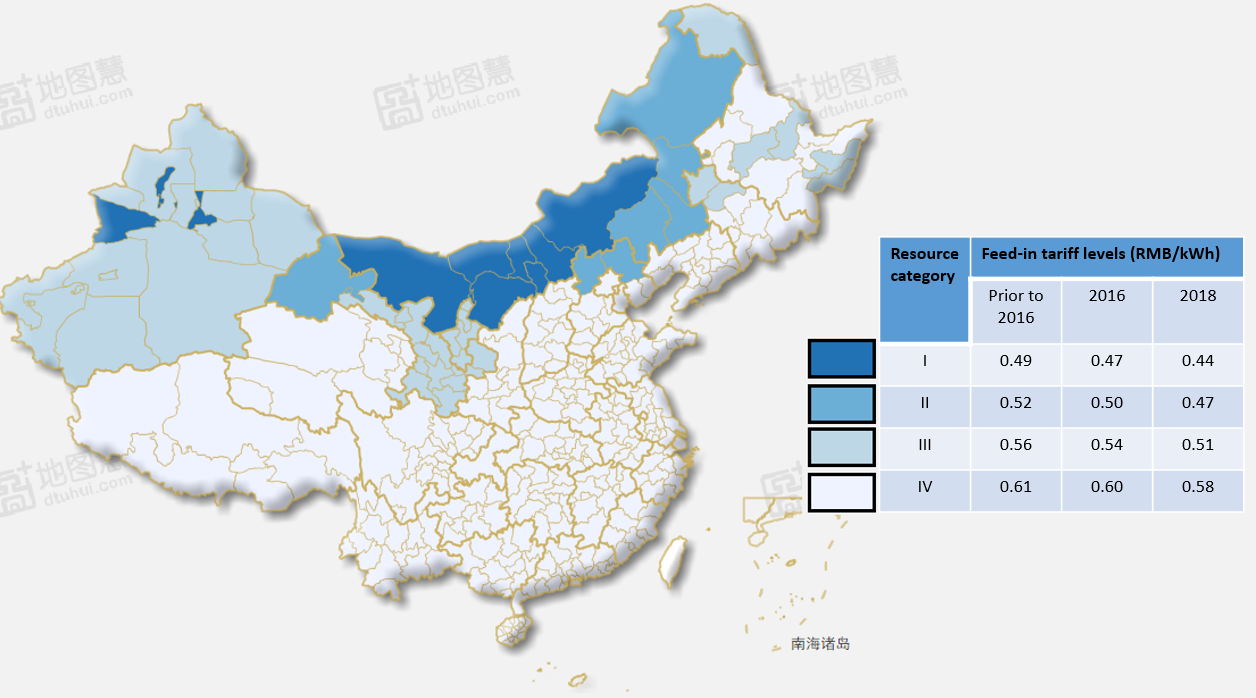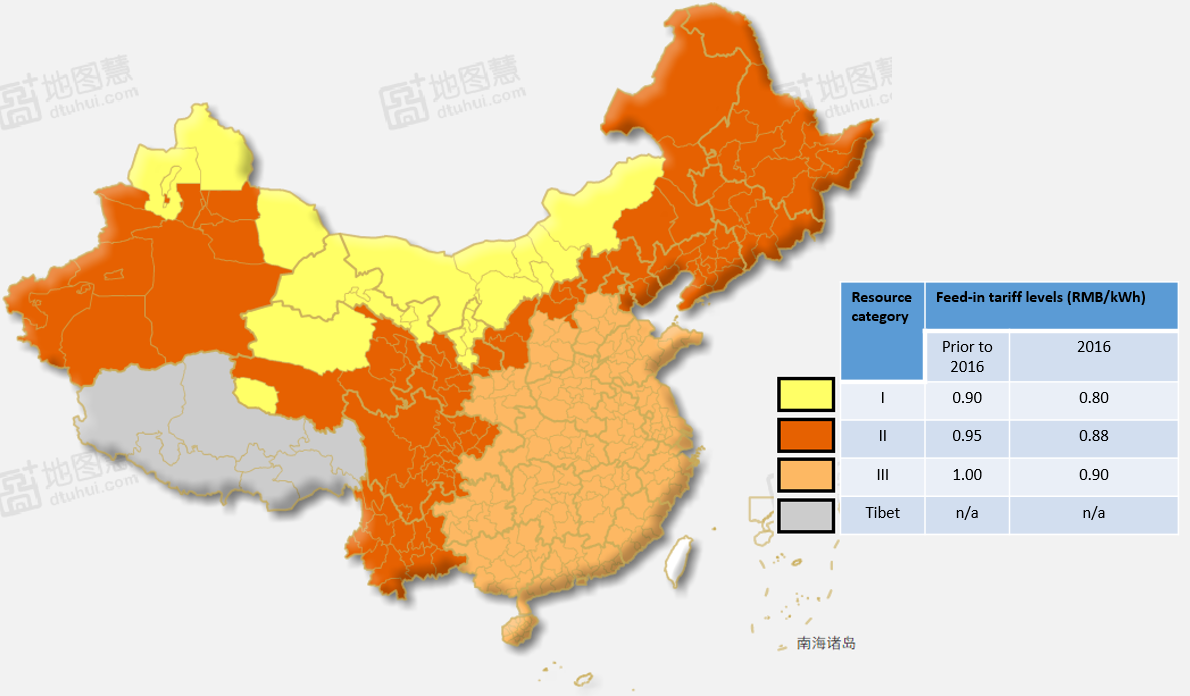All translations on this site are unofficial and provided for reference purpose only.
To view translations, select English under Step 1 (at the right of the screen). Not every item is (fully) translated. If you’re still seeing Chinese, you can use machine translation, under Step 2, to make sense of the rest.
Want to help translate? Switch to English under Step 1, and check ‘edit translation’ (more explanation in the FAQ). Even if you translate just a few lines, this is still very much appreciated! Remember to log in if you would like to be credited for your effort. If you’re unsure where to start translating, please see the list of Most wanted translations.
Circular on improving the onshore wind & PV benchmark feed-in tariff policy
Original title: 国家发展改革委关于完善陆上风电光伏发电上网标杆电价政策的通知
Links: Original CN (url).
National Development and Reform Commission
Circular on improving the onshore wind & PV benchmark feed-in tariff policy
NDRC Pricing department, doc. no. 3044 [2015]
Development and Reform Commissions, and Pricing Bureaus of Provinces, autonomous regions and municipalities:
In order to meet the targets of the "Strategic energy action plan (2014-2020)" of the General Office of the State Council, rationally guide renewable energy investment, promote the healthy and orderly development of onshore wind, PV, and other renewable energy industries, promote a balanced development of renewable energy in each locality, increase the efficiency of subsidies to electricity prices from the Renewable Energy Fund, and in accordance with the "Renewable Energy Law", it has been decided to adjust the benchmark feed-in tariff for new onshore wind and PV power generation projects。Having reached agreement with the National Energy Agency, notice is hereby given of the following:
1. Implementation of a policy to gradually reduce the benchmark feed-in tariff for onshore wind and PV power generation (meaning PV stations, throughout the text below) following the increasing scale of development。Because of a clear investment outlook, the benchmark feed-in tariff for onshore wind power is simultaneously decided for 2016 and 2018 ;For PV the benchmark feed-in tariff is decided for 2016, the tariff for 2017 and later shall be formulated separately。Specific benchmark feed-in tariffs are included in Annex I and II。
2. Distributed PV power generation projects constructed on rooftops or other sites may, at the time of registration select one of two models; either "consume what is generated, and put the rest on the grid", or "feed-in the total amount generated";Projects that have selected the model of "consume what is generated, and put the rest on the grid", are allowed to change to "feed-in the total amount generated", in case own power demand is significantly reduced (or has disappeared) or the power supply and demand can not be balanced。"Feed-in the total amount generated" projects will receive the local benchmark feed-in tariff for PV from the power grid enterprise。When changing to a "feed-in the total amount generated" model, the project shall apply to the local energy authority for changes in registration, and shall not change back to "consume what is generated, and put the rest on the grid" model。
3. The part of the feed-in tariff for onshore wind and PV power equal to the locally applicable tariff for coal-fired power (including desulfurization, denitrification, dust removal), is settled with the local provincial power grid company;the part exceeding this is subsidized by the National Renewable Energy Development Fund。
4. It is encourage to determine the ownership and feed-in tariffs for renewable energy projects such as PV and onshore wind power generation through tenders and other competitive market mechanisms, but the tariff determined through such mechanisms, may not exceed the benchmark feed-in tariff decided by the State for the locality。
5. Each onshore wind power or PV power generation companies and power grid enterprises must truthfully and completely record and preserve information on the amount, price, and subsidy amount etc., of the power fed in to the grid by the renewable power project, and accept supervision and inspection by the relevant departments。Pricing departments at all levels should strengthen supervision of the implementation of renewable feed-in tariffs and the settlement of renewable energy development fund subsidies for onshore wind power and PV power generation projects, and urge implementation of relevant policies on grid tariffs up to the required standard。
6. The above-mentioned regulations are effective starting January 1, 2016。
Annex:1. National onshore wind benchmark feed-in tariffs list
2. National PV benchmark feed-in tariffs list
National Development and Reform Commission
December 22, 2015
Annex
National onshore wind benchmark feed-in tariffs list
Unit:RMB/kWh (including tax)
| Resource category area | Onshore wind power benchmark feed-in tariff | Resource area includes | |
| 2016 | 2018 | ||
| Class I resource area | 0.47 | 0.44 | Inner Mongolia: areas other then Chifeng, Tongliao, Xing'an League, Hulunbeier;Xinjiang: Ili Kazakh Autonomous Prefecture, Karamay, Shihezi City |
| Class II resource area | 0.50 | 0.47 | Hebei: Zhangjiakou, Chengde;Inner Mongolia: Chifeng, Tongliao, Xing'an league, Hulunbeier;Gansu: Jiayuguan, Jiuquan |
| Class III resource area | 0.54 | 0.51 | Jilin: Baicheng, Songyuan;Heilongjiang: Jixi, Shuangyashan, Qitaihe, Suihua, Yichun, Daxing'an;Gansu: areas other than Jiayuguan, Jiuquan;Xinjiang: areas other than Ili Kazakh Autonomous Prefecture, Karamay, Shihezi City;Ningxia Hui Autonomous Region |
| Class IV resource area | 0.60 | 0.58 | Areas not included in Class I, II, or III resource areas |
Note:The 2016 or 2018 benchmark feed-in tariff is applicable to onshore wind power generation projects which were approved after January 1, 2016 or 2018, respectively 。The benchmark feed-in tariff at the moment of approval will not apply for projects that have not started construction within 2 years since approval。The 2016 benchmark feed-in tariff is applicable to onshore wind power generation projects which were approved prior to 2016, but have not started construction prior to the end of 2017。2. In case of significant changes to investment or operational costs of new onshore wind power projects prior to 2018, the national government may adjust the above-mentioned benchmark price, in line with such changes。
 [Image added by China Energy Portal; map created on dituhui.com (link)]
[Image added by China Energy Portal; map created on dituhui.com (link)]
Annex 2
National PV benchmark feed-in tariffs list
Unit:RMB/kWh (including tax)
| Resource category area | Benchmark feed-in tariff for PV power plants | Resource area includes |
| Class I resource area | 0.80 | Ningxia; Qinghai: Haixi; Gansu: Jiayuguan, Wuwei, Zhangye, Jiuquan, Dunhuang, and Jinchang; Xinjiang: Hami, Tacheng, Altay, Karamay; Inner Mongolia: areas other than Chifeng, Tongliao, Xing'an League and Hulunbeier |
| Class II resource area | 0.88 | Beijing; Tianjin; Heilongjiang; Jilin; Liaoning; Sichuan; Yunnan; Qinghai; Gansu; Inner Mongolia: Chifeng, Tongliao, Xing'an League and Hulunbeier; Hebei: Chengde, Zhangjiakou, Tangshan, and Qinhuangdao; Shanxi: Datong, Shuozhou, and Xinzhou; Shaanxi: Yulin, Yan'an; Xinjiang: areas not included in class I resource areas |
| Class III resource area | 0.98 | Areas not included in Class I or II resource areas |
Note:1. The 2016 benchmark feed-in tariff is applicable to PV power generation projects which were registered and included in the annual subsidy policy quota after January 1st, 2016。The 2016 benchmark feed-in tariff is applicable to PV power generation projects which were registered and included in the annual subsidy policy quota prior to 2016, but have not started operating prior to June 30th, 2016。2. The benchmark feed-in tariff for PV for Tibet is formulated separately。
 [Image added by China Energy Portal; map created on dituhui.com (link)]
[Image added by China Energy Portal; map created on dituhui.com (link)]
